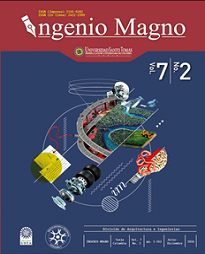Determination of the fractions of organic carbon in the ground of the Páramo La Cortadera – Boyacá
Main Article Content
Abstract
Downloads
Article Details
DECLARATION OF ORGINIALITY OF SUBMITTED ARTICLE
With this document, I/We certify that the article submitted for possible publication in the institutional journal INGENIO MAGNO of the Research Center Alberto Magno CIIAM of the University Santo Tomás, Tunja campus, is entirely of my(our) own writing, and is a product of my(our) direct intellectual contribution to knowledge.
All data and references to completed publications are duly identified with their respective bibliographical entries and in the citations thus highlighted. If any adjustment or correction is needed, I(we) will contact the journal authorities in advance.
Due to that stated above, I(we) declare that the entirety of the submitted material is in accordance with applicable laws regarding intellectual and industrial property, and therefore, I(we) hold myself(ourselves) responsible for any complaint related to it.
If the submitted article is published, I(we) declare that I(we) fully relinquish publishing rights of the article to the University Santo Tomás, Tunja campus. As remuneration for this relinquishment of rights, I(we) declare my(our) agreement to receive two (2) copies of the edition of the journal in which my(our) article appears.
References
Galvis, M. y Morales, M. (2010), Páramos de Boyacá: Flora representativa. Tunja: Corpoboyacá.
Van der Hammen, T. (2007). Los páramos: archipielagos terrestres en el norte de los Andes. En M. Morales et al., Atlas de páramos de Colombia. Bogotá. Bogotá: Instituto de Investigación de Recursos Biológicos Alexander von Humboldt.
Instituto Alexander Von Humbolt, (2009). En M. Galvis y M. Morale, (Eds.), Páramos de Boyacá: Flora representativa. Tunja: Corpoboyacá.
Instituto de Hidrología, Meteorología y Estudios Ambientales (Ideam), Ministerio del Medio Ambiente y Programa de las Naciones Unidas Para el Desarrollo (PNUD) (2002). Páramos y Ecosistemas Alto Andinos de Colombia en condición Hot Spot & Global Climatic Tensor. Bogotá: Autor.
Pla, I. (1994). La materia orgánica y la degradación y erosión de suelos en el trópico. En Mmemorias del VII Congreso Colombiano de la Ciencia del Suelo (pp. 3847). Bucaramanga: Sociedad Colombiana de la Ciencia del Suelo.
García, J. (2003). Análisis del potencial de emisión de dióxido de carbono del páramo de Chingaza y lineamientos para su conservación en el contexto del mecanismo de desarrollo limpio (tesis de grado para optar el título de Ecólogo). Bogotá: Pontificia Universidad Javeriana.
Jackson, M. (1964). Análisis químico de suelos. Barcelona: Omega.
García, A. (2002). Manejo de la degradación del suelo. Ciencia del Suelo, 309-353.
Burbano, H. (1989). El suelo: Una visión sobre sus componentes biorgánicos. Pasto: Universidad de Nariño.
Jaramillo, D. (2002). Introducción a la ciencia del suelo. Medellín: Universidad Nacional de Colombia.
Díaz, J. L. (2010). ¿Is soil carbon storage underestimated? Chemosphere, 80, 346–349.
Corpoboyacá & Ecosistema Colombia (2008). Evaluación del estado de conservación de cuatro especies de frailejones amenazadas (Espeletia paipana, Espeletia chocontana, Espeletia oswaldiana, Espeletia brachyaxiantha sub sp. pescana) del Departamento de Boyacá. Tunja: Autor.
Armas, C. M., Mora J. L., Arbelo C. D. y Rodríguez, A. (2013). Labile carbon pools and biological activity in volcanic soils of the Canary Islands. Spanish Journal of Soil Science, 3(1).
Diekow, J., Mielniczuk, J., Knicker, H., Bayer, C., Dick, D. P. y Ko, I. (2005). Soil C and N stocks as affected by cropping systems and nitrogen fertilization in a southern Brazil Acrisol managed under no-tillage for 17 years. Soil and Tillage Research, 81, 87-95.
Eiza, M., Fioriti, N., Studdert, G. y Echeverría, H. (2005). Fracciones de carbono orgánico en la capa arable: efecto de los sistemas de cultivo y de la fertilización nitrogenada. Ciencia del Suelo, 23(1), 59-67.
Kirkby, M. J. y Morgan, R. P. (1984). Erosión del suelo. Ciudad de México: Limusa.
Rondón, M. (2000). Los páramos andinos frente al calentamiento global. Historia de una sed anunciada. Revista Investigación y Ciencia, 9, 46-53.
Carter, M. (2002). Soil quality for sustainable land management: organic matter and aggregation interactions that maintain soil functions. Agronomic Journal, 94, 38-40.
Instituto Geográfico Agustín Codazzi (1988). Estudio semidetallado de suelos de áreas representativas de los páramos de Sumapaz, Neusa y Chingaza (Departamento de Cundinamarca). Bogotá: Autor.
Dale, V. (1997). The relationship between Land-use Change and Climate Change. Ecological Applications, 7(3), 753-769.
Ibrahim, M., Chacón, M., Cuartas, C., Naranjo, J., Ponce, G., Vega, P., Casasola, F. y Rojas, J. (2007). Almacenamiento de carbono en el suelo y la biomasa arbórea en sistemas de usos de la tierra en paisajes ganaderos de Colombia, Costa Rica y Nicaragua. Agroforestería en las Américas, 45, 27-36.

